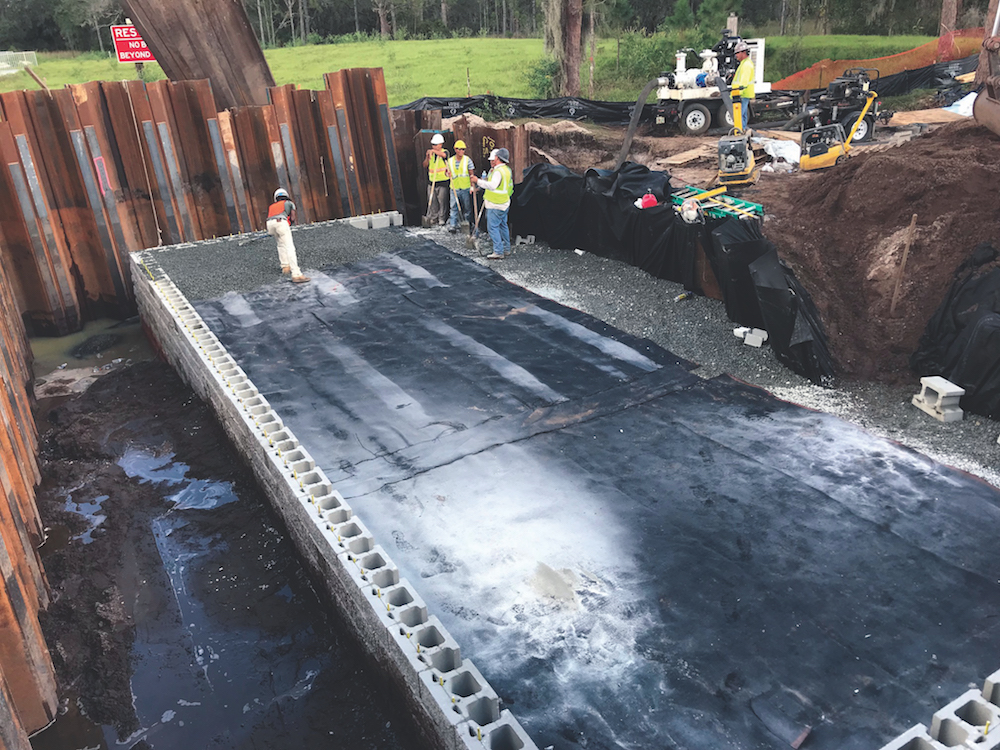New technologies and materials are helping states and local public agencies meet the country’s high demand for infrastructure improvements. One that’s seen more widespread implementation in recent years facilitates building bridges better and faster while improving maintenance for longer bridge life. It involves bridge abutments and is known as the geosynthetic reinforced soil integrated bridge system (GRS-IBS).
GRS-IBS is a relatively new bridge construction method that was initially developed in the mid-1990s at the Federal Highway Administration (FHWA) based on 20 years of research and experience with GRS walls. FHWA has published design and construction guidelines for the GRS-IBS (FHWA-HRT-11-026). The method is one example of FHWA’s goal to take effective, proven and market-ready technologies and get them into widespread use across the country.
Defining the separate parts of the system, GRS is an engineered, well-compacted granular fill with closely spaced (one block maximum) layers of geosynthetic reinforcement. IBS is a short-schedule, cost-effective method of bridge support that blends the roadway into the superstructure using GRS technology. These abutments are shallow foundations constructed using a combination of gravel and the layers of geotextile. The approach to the bridge is integrated into the GRS abutment in lieu of using an approach slab.
The method is meant for use on small, single-span bridges, although some multi-span structures have been built. It has been particularly popular in Florida with the Florida Department of Transportation (FDOT). An example of the more widespread use of GRS abutments is in Polk County, Florida, where FDOT’s Cow Camp Road bridge project has recently been completed. The project involved new roadway construction and a new bridge to replace the existing deteriorating structure on Cow Camp Road in Lake Kissimmee State Park in Polk County. The area is rural with lowland terrain.
Generally, the requirements for abutments and wing walls with the GRS-IBS system are that the facing elements be split-face CMU block with specific dimension ranges. Right angle wall corners with CMU corner blocks must have architectural detail on two sides. The block needs to be readily available, inexpensive, compatible with the frictional connection to the reinforcement, and meet specific material specifications in terms of compressive strength and water absorption limits.
In Florida, Keystone’s Compac® III wall system has met these criteria and been approved by FDOT. On this project, Keystone was selected after FDOT determined the new bridge was eligible for federal funding using the GRS-IBS system; Compac III suited the design parameters and has been approved as a “segmental block FDOT wall type.” 
The Compac III unit is a 12-inch-deep unit with a typical face width of 18 inches by 8 inches high. Units weigh from 67 to 89 pounds each. A dual pin hole configuration allows 1-degree, 4-degree, and 8-degree setbacks. For design purposes, the in-place density of the aggregate-filled unit is 120 pcf.
GRS-IBS with Keystone’s Compac III wall system was an optimal choice for the bridge design for several reasons, one of them being that it works well for this type of site, where the bridge is smaller and where lighter, more transportable equipment can be used.
Other advantages to using GRS-IBS and Keystone Compac III is a high degree of cost savings, averaging 25 to 60 percent below standard bridge construction according to the FHWA. Material costs are reduced, and maintenance costs would likely also be reduced since the system has fewer parts than a conventional bridge system and is jointless.
Keystone’s engineering department provided shop drawings, which were based on the project plans prepared by the FDOT structures office. The total square footage of wall/abutment area is 2,314 sf, with a height of 15.33 feet. The combined length is 77 feet.
This is the first GRS-IBS project Keystone has done in Florida, with two more pending. Use of GRS abutments and walls on interstate or major multi-lane highways requires the approval of the state structures design engineer.
